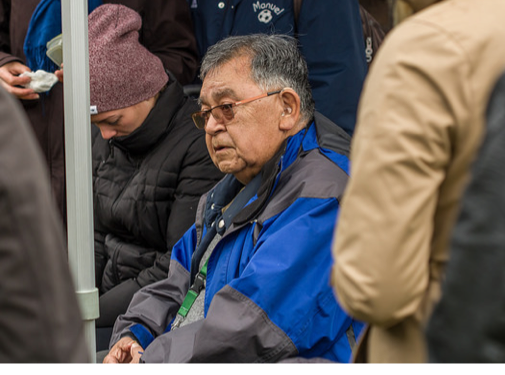Section 5: Winapee (Future)
Winapee (Future)
Creation
I know nothing
of great mysteries
know less of creation
I do know
that the farther backward
In time that I travel
the more grandmothers
and farther forward
the more grandchildren
I am obligated to both– Lee Maracle (1996, p. 8)
Purpose of this Section
Apply what you have learned to your practice.
On completing this section you will be able to:
- recognize processes that influence Indigenization.
- implement aspirations for Indigenization.
Estimated time to complete this section is four hours. Activities can be done either individually or as a group.

Elder Skip Dick reminded us that children are the reason why we do the important work of Indigenization in education. Indigenous teachings are mindful of the past, present, and future. Indigenization should reflect the teachings of ancestors and keep the needs of future generations at its core. The leaders interviewed for this guide were asked what they hope to see 25 years in the future in regard to Indigenization.
Angus Graeme said that Selkirk College will soon be delivering a new three-credit course, Regional Perspectives, developed by experts and knowledge-keepers from partner nations. New ideas around supporting First Nations and Métis students to transition to employment are taking shape and inspiring the college. He added:
All of this work and the plans we have for the future related to indigeneity, decolonization, and reconciliation at Selkirk College start with students at the centre. The work is fundamental and transformative for our college. We are serving our students, Indigenous and non-Indigenous, more effectively and more completely, and we are providing important leadership in our communities. We are a much better and complete college on this journey. And we continue to improve. The journey is long but worth every step….
What does Indigenization look like in 25 years? I believe that for a college to be successful, Indigeneity will be so engrained in the governance, operations, courses, programs, and services at the college that the term Indigenization will no longer be needed. Indigenous students will be confident and successful, proud of who they are, and proud of their cultures, traditions, and languages. We will have increased the number of faculty and staff who identify as Indigenous. The college will be a vibrant place of learning. Wouldn’t it be amazing if 25 years from now (if not sooner!) the president of the college were an Indigenous person and a Selkirk College alumni?
Ian Humphries shared the following:
In terms of the dream piece, I would love to be in a place, and this is referenced in our Reconciliation Plan, where everyone has the knowledge, there is no more ignorance about what happened in Canada historically with respect to colonialism and its impact. Camosun will be a place where Indigenous students feel very comfortable and supported, and it’s a place where our non-Indigenous students develop a much better understanding of Canada’s history.
John Boraas values the idea of the seven generations, the Indigenous pedagogy that encourages learners to consider the three previous generations, while looking ahead at the next four generations. He hopes that this perspective becomes engrained into institutional governance and planning.
Kendra Underwood shared the vision of growing the tribal school. She said:
I think it would be amazing to look forward to see First Nation satellite campuses very closely attached to our post-secondary institutions. I think that would also help us to alleviate a misconception that still is present, not only within the partnerships at times, but in the province around post-secondary community-based partnerships as simply being a facility rental agreement. And for anyone that works in community-based education and delivers partnership programming, we know that our programs are so much more than a fee-for-service or a facility-rental agreement.
Corrine Michel said:
Our vision for Indigenization at Camosun is for Indigenous ways of knowing and being, doing and relating to become natural at the college. I think this is already happening; people do consider Indigenization. They don’t always know how to do it, but before, they weren’t even aware of having to ask the question and they were just trying to get around it – in curriculum approval processes, for example. I now see people really understanding the value and necessity of Indigenization by building relationships, and ensuring that Indigenous Peoples are seen in a positive light by bringing Indigenous scholarship into courses. Incorporating the circle of courage into curriculum is something I hope for, so that some of those affective elements like sense of belonging and sharing and generosity are incorporated into the way courses are run.
Linda Smith suggested that teachers must “love our children as learners, and empower them with the courage they need to journey into the future with all the hopes and dreams of their ancestors.” Further, she noted, “educational success gives our people options to decide their own future.”
The journey to Indigenize is not a journey to take lightly; in fact, you must be well prepared for such a challenging but rewarding journey. We know that for the journey to be a success, the launch will require teamwork, as it cannot be done in isolation. This journey prepares us to paddle together in one direction, to discover the unknown, and to gather the newly acquired knowledge and bring it home to share
The journey to Indigenize your practice also provides space for other important aspects of education, such as diversity and inclusion. In this respect, to Indigenize your practice in post-secondary education is to humanize your practice.
Media Attributions
- Fig 5.1: Camas Pit Cook Oct 19 2017-054 © Camosun College AV Services is licensed under a CC BY-NC (Attribution NonCommercial) license

